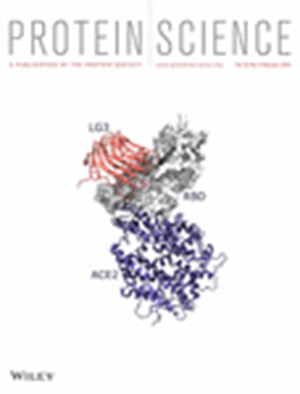O‐GlcNAc modification of HSP27 alters its protein interactions and promotes refolding of proteins through the BAG3/HSP70 co‐chaperone
IF 4.5
3区 生物学
Q1 BIOCHEMISTRY & MOLECULAR BIOLOGY
引用次数: 0
Abstract
Almost all types of cellular stress induce post‐translational O‐GlcNAc modifications of proteins, and this increase promotes cell survival. We previously demonstrated that O‐GlcNAc on certain small heat shock proteins (sHSPs), including HSP27, directly increases their chaperone activity as one potential protective mechanism. Here, we furthered our use of synthetic proteins to prepare biotinylated sHSPs and show that O‐GlcNAc modification of HSP27 also changes how it interacts within the sHSP system and the broader HSP network. Specifically, we show that O‐GlcNAc modified HSP27 binds more strongly to the co‐chaperone protein BAG3, which then promotes refolding of a model substrate by HSP70. We use proteomics to identify other potential HSP27 interactions that are changed by O‐GlcNAc, including one that we confirm with another sHSP, αB‐crystallin. These findings add additional evidence for O‐GlcNAc as a switch for regulating protein–protein interactions and for modifications of chaperones as one mechanism by which O‐GlcNAc protects against protein aggregation.HSP27 的 O-GlcNAc 修饰会改变其与蛋白质的相互作用,并通过 BAG3/HSP70 协同伴侣促进蛋白质的再折叠
几乎所有类型的细胞应激都会诱导蛋白质的翻译后 O-GlcNAc 修饰,这种修饰的增加会促进细胞存活。我们曾证实,包括 HSP27 在内的某些小热休克蛋白(sHSPs)上的 O-GlcNAc 可直接增加其伴侣活性,这是一种潜在的保护机制。在这里,我们进一步利用合成蛋白制备生物素化的 sHSP,并证明 HSP27 的 O-GlcNAc 修饰也会改变它在 sHSP 系统和更广泛的 HSP 网络中的相互作用方式。具体来说,我们发现经 O-GlcNAc 修饰的 HSP27 与共伴侣蛋白 BAG3 的结合更强,从而促进 HSP70 对模型底物的重折叠。我们利用蛋白质组学鉴定了其他可能被 O-GlcNAc 改变的 HSP27 相互作用,其中包括我们与另一种 sHSP αB-结晶蛋白的相互作用。这些发现进一步证明了 O-GlcNAc 是调节蛋白质间相互作用的开关,也证明了伴侣蛋白的修饰是 O-GlcNAc 防止蛋白质聚集的机制之一。
本文章由计算机程序翻译,如有差异,请以英文原文为准。
求助全文
约1分钟内获得全文
求助全文
来源期刊

Protein Science
生物-生化与分子生物学
CiteScore
12.40
自引率
1.20%
发文量
246
审稿时长
1 months
期刊介绍:
Protein Science, the flagship journal of The Protein Society, is a publication that focuses on advancing fundamental knowledge in the field of protein molecules. The journal welcomes original reports and review articles that contribute to our understanding of protein function, structure, folding, design, and evolution.
Additionally, Protein Science encourages papers that explore the applications of protein science in various areas such as therapeutics, protein-based biomaterials, bionanotechnology, synthetic biology, and bioelectronics.
The journal accepts manuscript submissions in any suitable format for review, with the requirement of converting the manuscript to journal-style format only upon acceptance for publication.
Protein Science is indexed and abstracted in numerous databases, including the Agricultural & Environmental Science Database (ProQuest), Biological Science Database (ProQuest), CAS: Chemical Abstracts Service (ACS), Embase (Elsevier), Health & Medical Collection (ProQuest), Health Research Premium Collection (ProQuest), Materials Science & Engineering Database (ProQuest), MEDLINE/PubMed (NLM), Natural Science Collection (ProQuest), and SciTech Premium Collection (ProQuest).
 求助内容:
求助内容: 应助结果提醒方式:
应助结果提醒方式:


